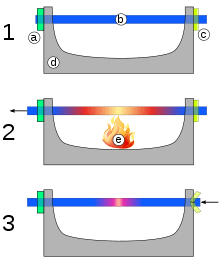Tyndall's bar breaker
Tyndall's bar breaker is a physical demonstration experiment to demonstrate the forces created by thermal expansion and shrinkage.

Setup
The bar breaker experiment comprises a very rigid frame (d) and a massive connecting rod (b). The rod is held on one side by a cast iron bar (c) that is going to be broken in the experiment and, at the other end, by a nut (a) that is used to compensate the thermal expansion.[1]
Procedure
During the experiment the steel rod (b) is heated with a flame (e) up to red heat temperature. During the heating phase the thermal expansion of the rod (b) is compensated by tightly fastening the nut (a). Taking away the flame starts the cooling phase. Typically the bar (c) breaks within a few minutes with a loud bang[2] or it is at least deformed significantly.
References
- Manual for Tyndall's bar breaker experiment (PDF)
- "Video showing Tyndall's bar breaker experiment". Retrieved 2020-08-12., University of Würzburg, Germany
Media
